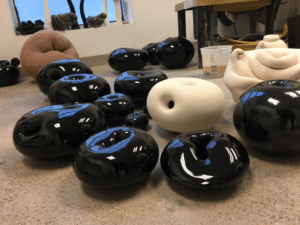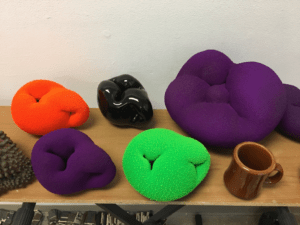In the fall of 2019, HCCC curatorial intern Felicia Leyva interviewed recent HCCC resident artist Maxwell Mustardo about his experimentation with surface texture and volumetric forms in his ceramic practice.

Felicia Leyva: When did you first begin working with clay, and what do you love most about this medium?
Maxwell Mustardo: I began dabbling with clay in high school, after being denied entry into my preferred class in film and video. I didn’t begin considering making ceramics as a kind of viable path until I started visiting Toshiko Takaezu in her home studio, which is nearby my family’s home in northern New Jersey. There’s very little that I dislike about clay. It’s an immensely expansive medium, from Neolithic cooking pots to NASA’s rocketship plating to geological structures to the curious things kindergarteners make. It is polyphonic—singing with multiple disparate voices in a single harmony. There are so many ways to approach and enjoy it.
FL: Are there any specific artists or movements that inspire or influence your work?
MM: Toshiko Takaezu and Ken Price would probably be the most direct and dominant influences in recent times. Toshiko’s poetic use of volume and roundness… Ken Price’s irreverent approach to the medium, absolutely resplendent surfaces, and intriguing forms. Both were prolific, dedicated makers. I’m drawn to that voracious intensity around production. Lots of other sources enter into my work—I’ll rattle off some, in no particular order: Yagi Kazuo, Anish Kapoor, Picasso’s and Braque’s early Cubist works, the Futurists’ textual works, ancient clay tablets, medieval Shigaraki ware, Takuro Kuwata… and so forth.

FL: Can you speak a little about what a toroid is and what drew you to experimenting with this form in your work? What led you to exploring with merging the toroid with the form of a coffee mug? What have you discovered from this process?
MM: The toroid is a form I’ve been working with for a couple of years now, on and off. For me, it’s been a kind of intersection of geometry, vessels, and bodies. I’m most interested in the continuous contour—an edgeless object—and stressing the relationship of interior and exterior. The mug series came out of similar notions. These mugs are a kind of a cliché jab, taking a classic, un-intrusive, and widely recognizable ceramic form and contorting it to satisfy my own desires.

FL: As part of your studio practice, you are constantly experimenting with glazes, which contribute to the unique textures and surfaces of your works. Can you elaborate on your creative process for experimenting with glazes?
MM: My making process is fairly organic. I usually work on a few series at once, slowly developing them and occasionally overlapping certain elements. Forms evolve the need for new surfaces, and the discovery of new surfaces requires new forms. Or, I’ll have one simple form, like the torus or mug, and I’ll take it around town with a number of different surfaces just to see what happens. There is a nice cycle that occurs, and momentum builds as new avenues continually open up. Generally though, the chemistry involved in clays and glazes is a magical thing. I am endlessly fascinated and often astonished by how these materials behave.

FL: When do you finally decide that a piece’s shape is finished?
MM: Clay is kind enough to nudge me and provide some natural deadlines. There is a lovely choreography involved with wet clay—only a certain number of moves are appropriate at various stages of drying. Timing is built into the material. Once things begin to get fired, it becomes a little more arbitrary. Some pieces go through many glaze firings until they don’t look awful, others sit around unglazed for a month until some potentially appropriate surface treatment presents itself. Nothing really seems finished until it leaves the studio and enters into the world.
FL: Could you let us know what you’ll be doing after your residency at HCCC, in December and into the new year?
MM: Starting January of 2020, I’ll be a resident ceramist at the Sonoma Community Center in Sonoma, CA. I currently have work on display at the Center for Contemporary Art in Bedminster, NJ; the Craft Forms 2019 show at the Wayne Art Center in Wayne, PA; the Dimensional show at the Sabine Gallery in Houston Texas; and the Twelfth Annual Cup Show: Form and Function at the Amelia Center Gallery in Panama City, Florida. I’ll be having my first solo show in April, 2020, at the Center for Contemporary Art in Bedminster, NJ; my first duo show in May, 2020, with Grant Akiyama at the Foothills Ceramic Art Museum in Auburn, CA; and my second solo show in June, 2020, at the Sonoma Art Center in Sonoma, CA.

